
Makati, officially the City of Makati, is a 1st class highly urbanized city in Metropolitan Manila, Philippines.

The coat of arms of the Philippines features the eight-rayed sun of the Philippines with each ray representing the eight provinces which were placed under martial law by Governor-General Ramón Blanco during the Philippine Revolution, and the three five-pointed stars representing the three major island groups of Luzon, the Visayas, and Mindanao.
A rip tide, or riptide, is a strong, offshore current that is caused by the tide pulling water through an inlet along a barrier beach, at a lagoon or inland marina where tide water flows steadily out to sea during ebb tide. It is a strong tidal flow of water within estuaries and other enclosed tidal areas. The riptides become the strongest where the flow is constricted. When there is a falling or ebbing tide, the outflow water is strongly flowing through an inlet toward the sea, especially once stabilized by jetties. During these falling and ebbing tides, a riptide can carry a person far offshore. For example, the ebbing tide at Shinnecock Inlet in Southampton, New York, extends more than 300 metres (980 ft) offshore. Because of this, riptides are typically more powerful than rip currents.

Taguig, officially the City of Taguig, is a 1st class highly urbanized city in Metropolitan Manila, Philippines. According to the 2015 census, it has a population of 804,915 people. The city is known for the Bonifacio Global City, one of the leading financial and lifestyle districts of the country, Arca South, a planned unit development located at the site of the former Food Terminal Incorporated (FTI) in Western Bicutan, and Bonifacio Capital District (BCD), where the future buildings of the Senate of the Philippines, the Supreme Court, and the Court of Appeals will be located. Taguig is also home of major shopping centers such as SM Aura Premier and Market! Market!, government agencies of Department of Science and Technology and Department of Energy, and notable memorial parks Manila American Cemetery and the Heroes' Cemetery.
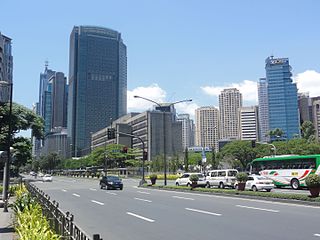
Ayala Avenue is a major thoroughfare in Makati, Philippines. It is one of the busiest roads in Metro Manila, crossing through the heart of the Makati Central Business District. Because of the many businesses located along the avenue, Ayala Avenue is nicknamed the Wall Street of the Philippines. It is also a major link between Epifanio de los Santos Avenue (EDSA) and Metropolitan Avenue. Part of Ayala Avenue from Metropolitan Avenue to Sen. Gil Puyat Avenue also forms Circumferential Road 3.
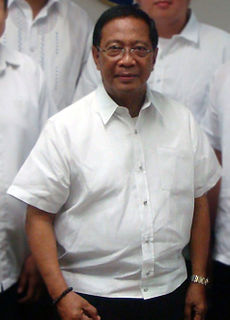
JejomarBinay^[b] is a Filipino politician who served as the 13th vice president of the Philippines under President Benigno Aquino III. Before becoming vice president, he was a long-time mayor of Makati. He ran as a presidential candidate in the 2016 Philippine presidential election, but lost. He currently serves as the Dean Emeritus of the University of Makati College of Law.

Enrico de Jesus Puno, better known as Rico J. Puno, was a Filipino singer, television host, actor, comedian & politician. He was considered as a music icon in the Philippines. He started the trend of incorporating Tagalog lyrics in his rendition of the American song The Way We Were and other foreign songs. Puno was known as a singer who regularly infused his on-stage performance with tongue-in-cheek comedy and adult humor. He hosted the noontime variety show Pilipinas Win na Win alongside Rey Valera, Marco Sison, and Nonoy Zuñiga for two months in 2010 replacing Kris Aquino. He also hosted on Happy Yipee Yehey! together with John Estrada, Randy Santiago, Mariel Rodriguez, Pokwang and Toni Gonzaga as one of the main host replacing Pilipinas Win na Win.

G.T. International Tower is an office skyscraper located in Makati, Philippines. The "G.T." in the name stands for George Ty, the building's owner and chairman of the Metrobank Group. Standing at 217 meters, it is currently the 12th-tallest building in the country and Metro Manila as well. The building has 47 floors above ground, and 5 basement levels for parking.

The University of Makati,, popularly known as UMak, is a public, locally funded city-flagship university in Makati City, National Capital Region, Philippines.

Day By Day Jesus Ministries is a non-denominational evangelical Christian mega-church organization headquartered in Makati City, Philippines, and its main worship center at the Folk Arts Theatre, Cultural Center of the Philippines, Manila.
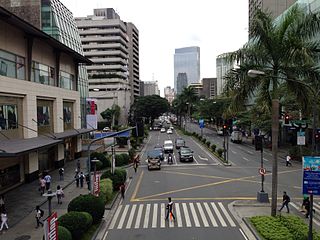
Makati Avenue is a major commercial thoroughfare in Makati, Metro Manila, Philippines. It forms the eastern border of Ayala Triangle and is one of the three main avenues of the Makati Central Business District. The avenue runs in a somewhat north-south diagonal direction almost parallel with Epifanio de los Santos Avenue (EDSA). It passes through two distinct neighborhoods of the city: the Makati CBD and the old Makati Población. At its northern end lies the older part of Makati starting from J.P. Rizal Avenue. It continues through Población to Gil Puyat Avenue, marking the southern edge of the old district. South of Gil Puyat onto the CBD, the avenue becomes more commercial and upscale. The shopping hub of Ayala Center and Arnaiz Avenue lie at its southern end.

Antonio S. Arnaiz Avenue, also known simply as Arnaiz Avenue and by its former names Libertad Street and Pasay Road, is a major east-west collector road that links Makati and Pasay in the Philippines. It stretches across western Metro Manila from Roxas Boulevard in the Santa Clara district of Pasay to Epifanio de los Santos Avenue (EDSA) in San Lorenzo Village in Makati.

The Makati Central Business District, also known as the Makati CBD, is the leading financial and central business district in the Philippines located at the heart of Makati in Metro Manila. It is politically known as "Central Cluster" in the West District of Makati. It is different from the civic center of Makati known as "Makati Poblacion" which is situated at the north-east portion of the district. It is bounded by EDSA, Gil Puyat Avenue, Arnaiz Avenue, and Chino Roces Avenue. The whole district occupies barangays of San Antonio, San Lorenzo, Bel-Air, and Urdaneta.

APEC Philippines 2015 was the year-long hosting of Asia-Pacific Economic Cooperation (APEC) summit which concluded with the APEC Economic Leaders' Meeting held on 18–19 November 2015 in Pasay, Metro Manila. It was the second time the Philippines hosted the summit, the first being the 1996 APEC summit.

Ruperto Cruz Santos, D.D., is a bishop of the Roman Catholic Church in the Philippines. He is the current Bishop of Balanga.

The Bantayog ng mga Bayani is a monument, museum, and historical research center in Quezon City, Philippines, which honors the martyrs and heroes of the struggle against the 21-year dictatorship of former President Ferdinand Marcos.
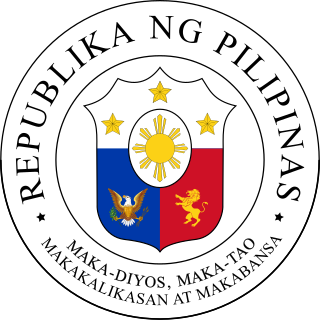
The Great Seal of the Philippines is used to authenticate official documents of the Philippine government. It may refer to the physical seal itself or the design impressed upon it. Under the law, the President of the Philippines is given the custody to the seal.
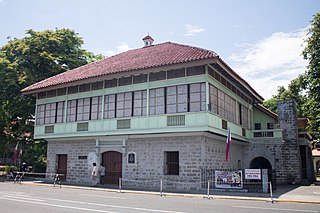
Bahay na bato is a type of building originating during the Philippines' Spanish Colonial period. It is an updated version of the traditional bahay kubo. Its design has evolved throughout the ages, but still maintains the bahay kubo's architectural basis which corresponds to the tropical climate, stormy season, and earthquake-prone environment of the whole archipelago of the Philippines and fuses it with the influence of Spanish colonizers and Chinese traders. Thus created was a hybrid of Austronesian, Spanish, and Chinese architecture with American influence during the American era, supporting the fact that the Philippines is a result of these cultures mixing together. Its most common appearance is that of an elevated, overhanging wooden upper-story nipa hut that stands on Spanish-style solid stone blocks or bricks and posts as foundation instead of just wood, bamboo stilts, or timber posts. Roofing is either Chinese tiled roof or thatch, of which many today are being replaced by galvanized or other modern roofing. It followed the bahay kubo's arrangements such as open ventilation and elevated apartments used as living space with the ground floor used for storerooms, cellars, and other business purposes. Like bahay kubo, much of this ground level was reserved for storage; in business districts, some spaces were rented to shops. Horses for carriages were housed in stables called caballerizas. Bahay na bato had a rectangular plan that reflected vernacular Austronesian Filipino traditional houses integrated with Spanish style.
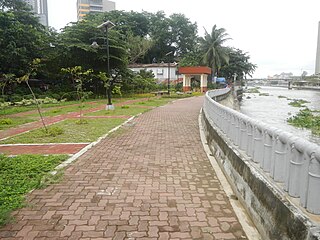
The Makati Poblacion Park, often shortened to Poblacion Park, is an urban linear park along the south bank of the Pasig River in Metro Manila, the Philippines. As its name suggests, it is located in the Poblacion village of Makati and was formerly known as Casa Hacienda Park. The park is the largest of three public parks in Makati's old downtown area situated at the site of a former plantation house. It is operated by the Department of Environmental Services Parks and Green Division of the City Government of Makati. Together with the Makati Poblacion Linear Park, the park has revitalized around 0.25 kilometers (0.16 mi) of Makati Poblacion's waterfront between the Makati-Mandaluyong Bridge and Rockwell Center.


















